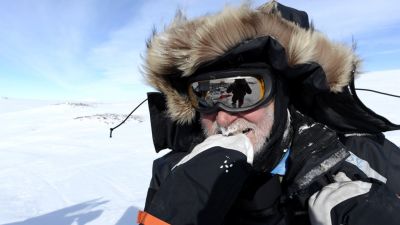
Dry continent, snowy coast
This Sunday, I learned that Antarctica was in fact a very dry continent and how aerosols and particles were playing a role in that dryness. Ironically, that was in stark contrast with the recent news from the coast, where our friends were getting massive amounts of snowfall dumped on them.
Remembering Queen Fabiola
Last Friday, we learned that Queen Fabiola had passed away. In sign of mourning, the Belgian flag at the station has been flying at half mast. It will stay that way for a few more days. After all, Princess Elisabeth is a little piece of Belgium in Antarctica, and we all wanted to pay our respects.
Bad weather at the coast delays progress
We had news from the team at the coast yesterday, and unfortunately the weather has been quite a hassle. It has been snowing very heavily. An entire day was lost for both for researchers and crew. Near white-out conditions make scientific work in the field impossible, and repairs on one of our venerable Prinoth tractors had to be postponed. This morning, one scientist even woke up to discover that the entire inside of his tent filled with snow overnight because of the wind.
Time is running short for the ICECON and BENEMELT scientists. They must soon leave their camp on the Derwael Ice Rise and move out close to the edge of the King Baudouin Ice Shelf, where they hope to drill a few 150 metre-deep ice cores, weather permitting. Let's hope the weather will be better soon so they can accomplish what they came for!
Particles, aerosols and snowfall
Meanwhile at the Princess Elisabeth station, our meteorologists, Alexander Mangold and Quentin Laffineur from the Royal Meteorological Institute of Belgium, spotted something unusual while monitoring aerosols in the upper atmosphere: their instruments recorded a very sudden and sharp increase in the number of particles in the atmosphere above Utsteinen. At 6,000 particles per cubic centimetre, their concentrations were 20 times the usual amount of particles in the atmosphere.
Alexander told me that this increase had nothing to do with pollution. He believes that it might have been triggered by turbulence in the upper layers of the atmosphere, where these particles are formed.
Particles and aerosols play a big role in Antarctica's climate, so it's nothing to worry about. They play a huge role in the formation of clouds. If there were no particles or aerosols in the atmosphere that moisture could adhere to, no droplets could form and there would be no clouds, precipitation or snow.
In the austral summer, average concentrations of atmospheric particles average around 300 particles per cubic centimetre. In the winter, concentrations drop to 10 or 12 particles per cubic centimetre (even the best "clean room" laboratories with fancy air pumps and filters would struggle to get to such low levels of particles).
That's why, contrary to popular belief, Antarctica is a very dry continent, with very little snowfall ... except at the coast these days it seems ...
Picture: Jos Van Hemelrijck's snowy moustache - © International Polar Foundation / Jos Van Hemelrijck
